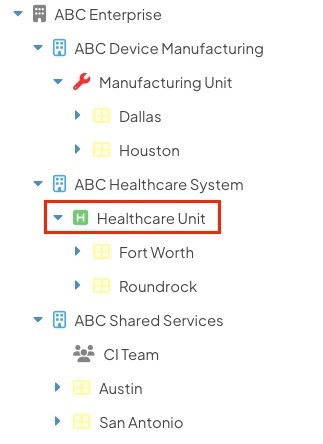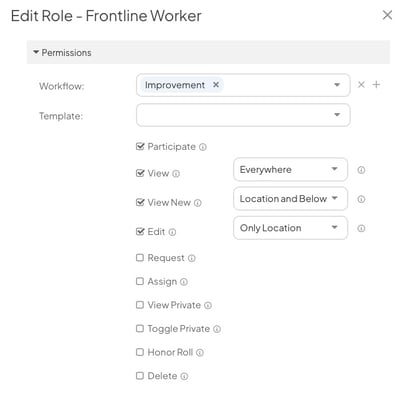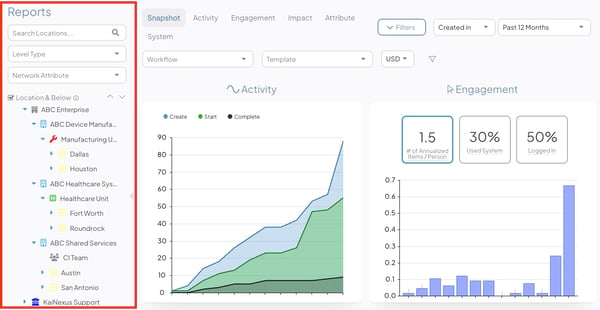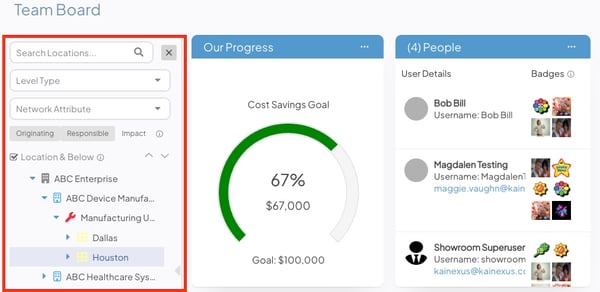What is a Network Location?
Learn about the purpose of a Network Location and how it affects your experience in KaiNexus
Every User in the system has at least one Network Location. It is a cornerstone of KaiNexus that affects what permissions you have, how Items are categorized, and how you can display data on Reports and Boards.
To understand Network Locations, it’s important to know two key pieces of terminology:
- A Network is the hierarchical structure of Locations within your organization that is used to organize people and improvement work into distinct areas. Networks sometimes mirror organizational charts, but they often have key differences depending on how your workflows are structured in comparison to how your people are structured.
- A Location is one division within the Network. All Users are assigned a Location, giving them access to ideas and projects within their division and associating their improvement efforts to that specific division of the organization.

Example of a Network. Healthcare Unit is one Location within the Network. Locations can be physical locations, sites, departments, teams, and more.
/Ofie/Ofie%20Profile%20Pic.png?width=50&height=50&name=Ofie%20Profile%20Pic.png) Pro Tip: A key difference between a Network and an Org Chart is that individuals should not be their own Location. Naming Locations after individuals will disrupt the Network if they leave or change roles. While designing a Network, ensure your Locations are sustainable through staffing changes.
Pro Tip: A key difference between a Network and an Org Chart is that individuals should not be their own Location. Naming Locations after individuals will disrupt the Network if they leave or change roles. While designing a Network, ensure your Locations are sustainable through staffing changes.
Networks are arranged in a hierarchy. At the top-level of the Network, you have one Location that represents the entire organization. All lower-level Locations are nested beneath it. As you move further down the Network, the Locations become more specified and representative of niche parts of the organization. This nesting structure allows for data from lower-level Locations to roll up to the higher-level Locations in their branch of the Network. This structure is especially important when reporting on your improvement work.
Each Location also has a Level Type, which is an additional way to classify the different tiers of your organization for reporting purposes. Click here to learn more about Level Types.
Overview
Keep reading this article to learn about:
What is the purpose of a Network?
To an individual, the purpose of the Network is to provide a place within the system where they can see and participate in work relevant to them.
However, the purpose of a Network to leaders, coaches, and executives focused on the organization as a whole is more expansive. For an organization, the purpose of a Network is to:
- Organize improvement work into functional areas, departments, work streams, or physical locations
- Define the level of visibility and access between divisions
- Provide a reporting framework to compare and measure work between Locations
Without a Network, you could report on the improvement work of individual people; however, you might not have an easy way to report on work done by teams, units, or departments. Network Locations group people together and allow you to report on their work as a unit.
Having a Network that fits your organization is crucial because a good Network helps you seamlessly report on improvement work, provide the right permissions to each staff member, and create small environments within the greater system were everyone can thrive in their unique role.
How does Location affect your experience in KaiNexus?
Your Network Location will impact your level of access within the system, determine how your Items are tagged, and help you filter data on Reports and Boards.
Permissions are based on Location
Your Network Location works together with your System Role to determine what Items you can interact with. System Roles accomplish this by granting certain Permissions in the following ways:
- Everywhere in the Network
- Only your Location
- Your Location and all Locations nested beneath it
Granting each Permission in a specified part of the Network allows organizations to customize what areas they want Users to access. You can have a focused experience where you only see your Location's work or a wider view where you can interact with improvement efforts across the entire organization.
For example, if the "View New" Permission is granted "Everywhere", the User would be able to see all public Items in the system. If this same Permission was granted to "Only Location", the User would only be able to see Items in their exact Location.

Example of a System Role with Permissions a Frontline User might have. Users with this Role will have widespread viewing Permissions but Edit access only in their Location. Note: this page is only viewable by people with Role Administrator included in their System Role.
/Ofie/Ofie%20Profile%20Pic.png?width=50&height=50&name=Ofie%20Profile%20Pic.png) Pro Tip: System Role Permissions aren’t the only way you can gain visibility into an Item. You’ll also be able to view an Item if you are added to the Item’s Team.
Pro Tip: System Role Permissions aren’t the only way you can gain visibility into an Item. You’ll also be able to view an Item if you are added to the Item’s Team.
Executives and KaiNexus Champions are typically located higher in the Network because they need visibility into many parts of the organization. Frontline workers are often located in one of the lowest nodes of the Network because they typically only need to interact with work immediately related to them.
Items have Locations
Every Item has a Network Location. There are three different types of Locations an Item can have.
- The Originating Location is where the work originated. Whether an Item has an Originating Location depends on the Team Type and how the Template is configured.
- The Responsible Location is where the work is being done and is always required on Items.
- Impact Locations are where the effect, or Impact, of the work materializes. Whether an Item has an Impact Location depends on how the Template is configured.
The same Location might be the Originating, Responsible, and Impact Location for an Item. However, there might also be a scenario where one Location comes up with an idea, another Location implements it, and the impact is felt by a third Location. In this scenario, differentiating between Originating, Responsible, and Impact Location is crucial to understand each Location's involvement in the work.
/Ofie/Ofie%20Profile%20Pic.png?width=50&height=50&name=Ofie%20Profile%20Pic.png) Pro Tip: An Item can also have a Participating Location, which is different from the other Location Types. Participating Location is only available on Advanced Teams and allows for the swift addition of all Users in a specific Location to an Item's Team.
Pro Tip: An Item can also have a Participating Location, which is different from the other Location Types. Participating Location is only available on Advanced Teams and allows for the swift addition of all Users in a specific Location to an Item's Team.
Tagging Items with Locations serves two primary purposes:
- An Item's Location helps with organization and categorization, which is especially useful for Reporting and Boards. Locations help you build insightful Reports and Boards customized with each Location's data.
- An Item's Location determines whether a User's System Role allows them to interact with it. For example, if your System Role allows you to edit Items in your Location, then you will be able to edit any Items where your Location is the Responsible Location, regardless of whether you are on the Item's Team.
/Ofie/Ofie%20Profile%20Pic.png?width=50&height=50&name=Ofie%20Profile%20Pic.png) Pro Tip: Item notifications can also be dependent on Location. You can design your notification preferences so that you receive alerts about Items in a specific Location, your Location, your Location and Below, or everywhere in the Network.
Pro Tip: Item notifications can also be dependent on Location. You can design your notification preferences so that you receive alerts about Items in a specific Location, your Location, your Location and Below, or everywhere in the Network.
Filter Reports and Boards by Location
Boards and Reports hold a lot of information, so customizing them to show purposeful data is crucial. A great way to do this is filtering by Location.
Filtering Boards and Reports by Location is primarily done through the Location Filter, which is a powerful tool that outlines the structure of your organization and allows you to filter data between different Locations.
- The Reports section of KaiNexus has a Location Filter on the left side of the page that is always available. Selecting a Location on the Filter will result in Reports that only show data from that Location. This helps you easily and quickly compare data between Locations.

- The Location & Below checkbox allows you to see Location information for a Location and all Locations nested below it.
/Ofie/Ofie%20Profile%20Pic.png?width=50&height=50&name=Ofie%20Profile%20Pic.png) Pro Tip: You can even multi-select Locations to report on more than one Location at a time.
Pro Tip: You can even multi-select Locations to report on more than one Location at a time.
- Some Boards have a Location Filter and some do not. If you have access to edit a Board, you can add a Location Filter. Selecting a Location on the Filter will result in Boards that only show data from that Location.

- Filtering Boards by Location helps you compare Locations and quickly switch back-and-forth between them.
- Board Location Filters can default to a specific Location or the viewer’s Location. This ensures staff are always seeing information relevant to their Location and aren't overwhelmed by extraneous data.
/Ofie/Ofie%20Profile%20Pic.png?width=50&height=50&name=Ofie%20Profile%20Pic.png) Pro Tip: You can also use a Quick Filter to filter Boards by Location. This is great if you want to save some space on your Boards.
Pro Tip: You can also use a Quick Filter to filter Boards by Location. This is great if you want to save some space on your Boards.
Recommended Reading
Now that you understand Network Locations, we recommend checking out these articles:
- Filter a Board by Location
- Filter a Report by Location
- System Role Permissions
- What is a Team?
- Starred Locations
Do you want a sharable resource that summarizes the information on this support page? Use the following link to download our Network PDF: